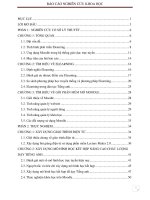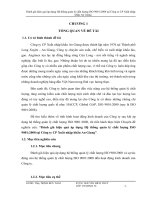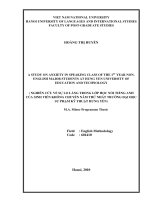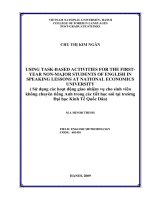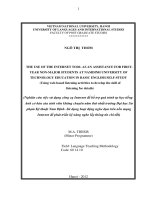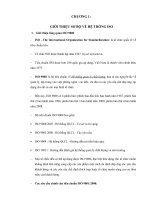- Trang chủ >>
- Luật >>
- Luật doanh nghiệp
ĐÁNH GIÁ HIỆU QUẢ SỬ DỤNG HỆ THỐNG PHẦN MỀM TIẾNG ANH CHO SINH VIÊN KHÔNG CHUYÊN TIẾNG ANH TẠI TRƯỜNG ĐẠI HỌC CÔNG NGHỆ THÔNG TIN VÀ TRUYỀN THÔNG – ĐẠI HỌC THÁI NGUYÊN
Bạn đang xem bản rút gọn của tài liệu. Xem và tải ngay bản đầy đủ của tài liệu tại đây (805.51 KB, 11 trang )
<span class='text_page_counter'>(1)</span><div class='page_container' data-page=1></div>
<span class='text_page_counter'>(2)</span><div class='page_container' data-page=2>
<i> </i>
T¹p chÝ Khoa häc và Công nghệ
CHUYấN SAN KHOA HỌC XÃ HỘI – NHÂN VĂN – KINH TẾ
Mơc lơc
Trang
Bùi Hồng Tân - Tình hình sở hữu ruộng đất công ở huyện Hà Châu, tỉnh Hà Tiên qua nghiên cứu tư liệu địa bạ
năm Minh Mạng thứ 17 (1836) 3
Đoàn Thị Yến - Vua Tự Đức với vấn đề Công giáo trước và sau năm 1862 9
Trần Minh Thuận - Vấn đề ruộng đất và các cuộc đấu tranh tự phát của nông dân ở tỉnh Bạc Liêu thời
Pháp thuộc 15
Đồng Văn Quân - Các kiểu chế độ dân chủ trong lịch sử và nền dân chủ xã hội chủ nghĩa ở nước ta hiện nay 21
Lê Thị Giang, Lê Thị Hương - Nguồn gốc hình thành tư tưởng Hồ Chí Minh về con người và xây dựng
con người 27
Cao Thị Phương Nhung, Ngô Thị Quang - Chủ tịch Hồ Chí Minh bàn về cơng tác học tập lí luận trong tác
phẩm “Diễn văn khai mạc lớp học lí luận khóa I trường Nguyễn Ái Quốc” 33
Lưu Thu Trang - Bi kịch của nhân vật Grigori Melekhov qua mối quan hệ với hai nhân vật nữ Aksinia và
<i>Natalia trong tác phẩm Sông Đông êm đềm (M. Sholokhov) </i> 39
<i>Hoàng Thị Tuyết Mai - Thế giới trăng trong thơ Nguyễn Huy Oánh </i> 45
Nguyễn Diệu Linh - Cá sỉnh trong văn hóa ẩm thực của người Thái trắng ở xã Sơn A, huyện Văn Chấn, tỉnh
Yên Bái 49
Nguyễn Thị Tân Tiến, Hà Thị Hằng - Sự khác biệt về kết quả chuẩn đầu ra tin học của sinh viên học học phần
Tin học đại cương với sinh viên đạt chứng chỉ IC3 ở trường Đại học Y – Dược, Đại học Thái Nguyên 55
Đầu Thị Thu - Rèn luyện nghiệp vụ sư phạm cho sinh viên thông qua hoạt động trải nghiệm thực tế nghề nghiệp 61
Nguyễn Ngọc Bính, Dương Tố Quỳnh - Thực trạng công tác kiểm tra, đánh giá kết quả học tập môn bóng
chuyền cho sinh viên trường Đại học Kinh tế và Quản trị Kinh doanh - Đại học Thái Nguyên 67
Lưu Quang Sáng - Một số phương pháp dạy học chữ Hán cho người Việt 73
Hoàng Thị Hải Yến - Vận dụng tư tưởng Hồ Chí Minh về đạo đức trong việc xây dựng đạo đức, lối sống cho
<i>sinh viên trường Đại học Kỹ thuật Công nghiệp – Đại học Thái Nguyên hiện nay </i>79
<i>Phùng Thị Tuyết, Nông Hồng Hạnh - Đánh giá trong dạy học qua đề án ở bộ môn tiếng Trung Quốc - Khoa </i>
Ngoại ngữ - Đại học Thái Nguyên 85
Trần Hoàng Tinh - Thực trạng và biện pháp xây dựng kế hoạch, chỉ đạo thực hiện giáo dục tính kỷ luật cho
sinh viên tại Trung tâm Giáo dục Quốc phòng và An ninh 91
Hồng Thị Lý - Vai trị của hoạt động giàn giáo trong việc làm tăng khả năng đọc hiểu tiếng Anh của sinh viên
năm nhất 97
Dương Thị Hồng An, Đặng Phương Mai - Đánh giá phần mềm hỗ trợ học tập và giảng dạy tiếng Anh tại
trường Đại học Công nghệ Thông tin và Truyền thông – Đại học Thái Nguyên 103
Tạ Thị Mai Hương, Nguyễn Vân Thịnh, Nguyễn Thị Hạnh Hồng - Tác động của việc sử dụng hồ sơ bài tập
lên sự phát triển kĩ năng nghe hiểu của sinh viên: nghiên cứu trường hợp tại trường Đại học Kinh tế và Quản trị
Kinh doanh – Đại học Thái Nguyên 109
Trần Tuấn Anh, Đỗ Văn Hải, Trần Thị Thu Thủy, Hoàng Văn Hùng - Nghiên cứu xây dựng cơ sở dữ liệu
đất đai đa mục tiêu phục vụ công tác quản lý tại phường Cốc Lếu, thành phố Lào Cai 115
Nguyễn Thị Gấm, Đào Thị Hương - Ảnh hưởng của chất lượng dịch vụ ngân hàng tới sự thỏa mãn của khách
hàng tại Vietinbank - chi nhánh Thái Nguyên 121
Nguyễn Thị Thanh Thủy - Đầu tư trực tiếp nước ngoài với sự phát triển kinh tế - xã hội Việt Nam 129
Journal of Science and Technology
175
(15)
</div>
<span class='text_page_counter'>(3)</span><div class='page_container' data-page=3>
Chu Thị Hà, Đỗ Thị Hà Phương, Nguyễn Thị Giang, Lin Xiao Wu - Nhân tố ảnh hưởng đến động lực làm
việc của người lao động tri thức tại Việt Nam 135
Trần Viết Khanh, Đỗ Thúy Mùi - Một số giải pháp phát triển nông nghiệp vùng Tây Bắc 141
Nguyễn Thị Lan Anh - Tăng cường quản lý sử dụng kinh phí cho hoạt động y tế tại Bệnh viện Đa khoa Trung
ương Thái Nguyên 147
Nguyễn Thị Giang, Đỗ Thị Hà Phương, Chu Thị Hà, Hồ Lương Xinh - Hiệu quả kinh tế trong sản xuất nấm
ăn của các hộ gia đình ở huyện Đại Từ, tỉnh Thái Nguyên 153
<i>Đỗ Thị Vân Hương - Phân tích hiệu quả mơ hình trồng cây cà phê chè (Arabica), cây mắc ca (Macadamia) tại </i>
xã Ẳng Tở, huyện Mường Ảng, tỉnh Điện Biên 159
Đặng Ngọc Huyền Trang, Dương Thị Thùy Linh - Xác định mối quan hệ giữa nguồn đầu tư trực tiếp nước
ngoài và cán cân thương mại ở Việt Nam 165
<i>Dương Thị Tình - Thực trạng tái cơ cấu doanh nghiệp nhà nước năm 2016 và giải pháp cho những năm tiếp theo </i> 171
Phạm Thị Thanh Mai, Nghiêm Thị Ngoan - Đảm bảo quyền sở hữu trí tuệ đối với sản phẩm chè mang chỉ dẫn
địa lý “Tân Cương” của tỉnh Thái Nguyên 177
Nguyễn Thị Thảo - Kết quả thực hiện chương trình giảm nghèo tỉnh Thái Nguyên giai đoạn 2011-2015 183
Nguyễn Thị Lan Anh, Đào Thị Hương - Phát triển mối liên kết các tác nhân trong chuỗi giá trị ngành hàng chè
tỉnh Thái Nguyên 189
Trần Thùy Linh, Đỗ Hoàng Yến - Hoàn thiện các quy định về xác định hành vi lạm dụng vị trí thống lĩnh thị
trường theo Luật Cạnh tranh 2004 195
Nguyễn Thị Mỹ Hạnh, Ngô Thị Quỳnh Trang, Phạm Thị Thu Phương, Hoàng Thị Lan Hương - Các rào
cản trong việc áp dụng tiêu chuẩn khách sạn xanh ASEAN tại Hà Nội 201
Phan Thị Vân Giang, Phạm Bảo Dương - Một số vấn đề lý luận và bài học kinh nghiệm liên kết kinh tế trong
</div>
<span class='text_page_counter'>(4)</span><div class='page_container' data-page=4>
<i>Dương Thị Hồng An và Đtg </i> Tạp chí KHOA HỌC & CƠNG NGHỆ 175(15): 103 - 108
103
AN EVALUATION ON THE EFFECTIVENESS OF THE ENGLISH SOFTWARE
SYSTEM FOR NON-ENGLISH MAJOR STUDENTS AT THAI NGUYEN
UNIVERSITY OF INFORMATION AND COMMUNICATION TECHNOLOGY
Duong Thi Hong An*, Dang Phuong Mai
<i> TNU University of Information and Communication Technology </i>
SUMMARY
CALL (Computer Assisted Language Learning) has proven its high effectiveness in the trend of
information and communication technology (ICT) applications in education and training in general
<i>and teaching English in particular. The project “Building the software system for supporting the </i>
<i>learning, teaching, reviewing and self-assessing English” funded by National Foreign Language </i>
Project 2020 and Thai Nguyen University (TNU) was piloted at University of Information and
Communication Technology (ICTU) from August 2015 to May 2016. The participants were 400
first-year undergraduates and 15 EFL lecturers at ICTU. Positive feedbacks via survey questionnaires
from the lecturers and the students were sent to the project group. Better study results made by the
first group of 200 students using the courseware compared with the ones made by the second group
of 200 students who did not use the courseware were also the proof of its effectiveness. This bright
perspective opened a broader implementation in the next stage of the project.
<i>Keywords: CALL; courseware; multimedia; evaluation; effectiveness.</i>
INTRODUCTION *
The use of ICT is one of the factors that
changed the Vietnamese students’ practice of
learning English as a foreign language. Such
views are in synchrony with the official
directive from the Ministry of Education and
Training, which urges EFL lecturers to
integrate multimedia and digital technology
into their teaching. At TNU, the project
<i>“Building the software system for supporting </i>
<i>the learning, teaching, reviewing and </i>
<i>self-assessing English” has been carried out by </i>
ICTU project group since 2015. The project
aims at supporting English teaching and
learning at TNU and enhancing CALL abilities
of both lecturers and students. In order to
examine the quality of this English language
teaching (ELT) multimedia courseware, it is
necessary to conduct quality evaluations on it.
Thus, we examined and evaluated this
multi-media courseware piloted at ICTU, TNU.
THEORETICAL REVIEW
Computer assisted language learning (CALL)
<i>CALL has been defined as “the search for </i>
<i>and study of applications of the computer in </i>
<i>language teaching and learning” [5]. </i>
*
<i>Tel: 0904 267 273, Email: </i>
Corresponding to the evolution of computer
technology in the past decades, the
development of CALL can be categorized
into three stages: behaviouristic CALL,
communicative CALL, and integrative CALL
[10]. The first stage of CALL has been
termed behaviouristic or structural CALL,
which was characterized by route learning in
the forms of pattern and drill exercises and
explicit instructions of grammar.
Communicative CALL emerged in late 1970s
and stressed that students should be
encouraged to produce language in authentic
communicative settings instead of
manipulating prefabricated forms. The mid
1990s witnessed the emergence of the
integrative CALL which sought to integrate
both basic language skills and computer
technology more naturally and fully into
language learning. Nowadays, the
digitali-zation of language materials through
</div>
<span class='text_page_counter'>(5)</span><div class='page_container' data-page=5>
<i>Dương Thị Hồng An và Đtg </i> Tạp chí KHOA HỌC & CƠNG NGHỆ 175(15): 103 - 108
104
potential to enhance the salience of language
features. Highlighting, colour-coding,
underlining, and font manipulation are typical
examples of visual input enhancement [6].
CALL was introduced into Vietnam in early
2000s and the research on English
instructional courseware in Vietnam lagged
behind that of their foreign peers who started
to investigate courseware in 1990s.
Furthermore, in the past decade, English
multimedia courseware has been widely used
in English teaching at tertiary level.
Therefore, there is a need to conduct an
evaluation on the quality of courseware,
which could not only guide courseware
design but also facilitate the development of
future courseware evaluation.
Courseware evaluation
Systematic evaluation of CALL courseware
generally fell behind the development efforts
[2]. Courseware evaluation refers to the
process of measuring the appropriateness and
effectiveness of a particular instructional
system [1], [3]. Hubbard stressed that
judgments made by instructors and learners
should be at the core of CALL software
evaluation so that teachers’ and learners’
considerations could be combined to yield
assessments of the appropriateness of a piece
of CALL courseware in a given context.
Several research has been done to evaluate
multimedia learning materials from both
teachers’ and students’ perspective [4], [9].
METHODOLOGY
Contents of the courseware
The frame of the courseware includes five main
<i>parts: Lecture Notes – Language Reference – </i>
<i>Practice – Mini-test – Trial Exam. </i>
The course books integrated in the system are
English Unlimited with 2 levels from A2 to
B1 [7], [8]. Currently, three TNU university
members are using them as the main course
books. These books aim at developing the
language knowledge and skills as in Common
European Framework Reference (CEFR)
from A1 to C1. The four skills associated
with Vocabulary, Grammar, Pronunciation,
Cultures are integrated in each book.
The English curriculum at TNU has from 10
to 12 credits, which is equivalent to 200
lecturing hours. With the average input level
of English is A1 while the English output
standard is A2 and B1. This means one level
raise of students’ language competence.
Based on previous studies, in order to reach
this goal, 300 to 600 class hours and
self-study should be met. However, due to time
constraints, it is hard to exploit the course
books. Therefore, the integration some parts
of these course books were integrated into the
courseware so that students can study on their
own, i.e., grammatical practice, reading,
listening, writing, pronunciation and
mini-tests. Both TNU lecturers and students can
exploit the learning and teaching recourses.
<i>The Grammar Reference is designed with </i>
theme-based units in which learners can be
supported online anytime when they want to
check grammar theories. They are in both
English and Vietnamese so that student can
understand easily.
<i>The Lecture Notes are lesson-based are </i>
designed for teachers and students to use in
class or at home since they are available
online. Teachers can actively share or upload
their teaching materials with other teachers or
students under the control of an professional
administrator.
</div>
<span class='text_page_counter'>(6)</span><div class='page_container' data-page=6>
<i>Dương Thị Hồng An và Đtg </i> Tạp chí KHOA HỌC & CÔNG NGHỆ 175(15): 103 - 108
105
<i>The Mini-tests are designed along with the </i>
contents of each unit so learners can review
and assess their progress themselves.
<i>The Trial Exam level from A2 to B1 is </i>
collected, processed and mixed to created
different trial test for learners to practice and
self-assess before they take real English
output exams at ICTU.
Participants
The first group of participants were 200
non-English major undergraduate EFL students
and 15 EFL teachers at ICTU, TNU. The
questionnaire survey was administered in a
laboratory where the instructors taught the
students English skills using the courseware.
The teacher questionnaire survey was carried
out in a meeting room after the teachers
delivered their lessons.
The second group of participants were 200
non-English major undergraduate EFL
stu-dents who did not use the courseware. Both
are at the same level of English language
competence (A1) based on their placement
test results. After 10 months, both groups
took the same final exams. The results of the
final semester exam results were compared.
Instruments
The first group of participants were given the
survey questionnaires to evaluate the
courseware after 10-month-use.
Eight courseware evaluation criteria include:
<i>(1) The contents provided in the courseware are </i>
<i>appropriate with the standardized curriculum. </i>
<i>(2) Users can use the system at the different </i>
<i>stages: building knowledge, reinforce and </i>
<i>improve skills, knowledge application, testing. </i>
<i>(3) The courseware creates the better and </i>
<i>favourable teaching and learning environment </i>
<i>than other traditional ones, which assists them </i>
<i>to be more active and creative. </i>
<i>(4) The courseware ensures the learning </i>
<i>objectives evaluated by the teachers for the </i>
<i>targeted students. </i>
<i>(5) The system assists users with creative </i>
<i>activities and with adjusting or adding </i>
<i>information to the system. </i>
<i>(6) </i> <i>The </i> <i>courseware </i> <i>is </i> <i>suitable </i> <i>for </i>
<i>psychological of learners without overloaded </i>
<i>knowledge and stress-free interface (colour, </i>
<i>design, audio….). </i>
<i>(7) The system helps users to solve problems </i>
<i>emerging while using and give timely feedback. </i>
<i>(8) The system can archive the studying </i>
<i>results and duration for learners and also for </i>
<i>the purpose of evaluation or research. </i>
The evaluation based on eight criteria with a
<i>five-point Likert-type scale: (1) Totally agree, </i>
<i>(2) Agree, (3) Not sure, (4) Disagree, (5) </i>
<i>Totally disagree. </i>
Survey results
<i>Table 1. Questionnaire survey results </i>
Criteria Totally
agree Agree
Not
sure
Dis-agree
Totally
disagree
Crit 1 133 65 9 5 3
Crit 2 146 54 7 6 2
Crit 3 125 72 6 8 4
Crit 4 117 75 12 8 3
Crit 5 131 65 8 7 4
Crit 6 123 69 14 6 3
Crit 7 112 70 18 7 3
Crit 8 134 75 4 2 0
Average 196 9,75 9,25
Percentage 91,2 4,5 4,3
From the table above, we can see that
majority of the participants totally agree/
agree (91,2%) with eight courseware
evaluation criteria while the number of
participants who are not sure, disagree
or totally disagree was minor (4,3-4,5%).
Compared final exam results
<i>Table 2. Compared final exam results of two groups </i>
Grade A B C D F
Group 1 ( Use the courseware)
Semester 1 15% 48% 22% 12% 3%
Semester 2 17% 45% 25% 11% 2%
Group 2 (Do not use the courseware)
Semester 1 5% 20% 49% 19% 7%
</div>
<span class='text_page_counter'>(7)</span><div class='page_container' data-page=7>
<i>Dương Thị Hồng An và Đtg </i> Tạp chí KHOA HỌC & CÔNG NGHỆ 175(15): 103 - 108
106
From the study results collected from
Department of Academic Affairs of ICTU, we
can easily see that the percentages of student
getting grade A, D, F from both group are
almost the same. The remarkable difference
can be shown in the percentage of students
getting grade B and C. In the first group,
nearly half can get grade B while in the
second one, only 20% of them can reach B.
Courseware analysis
<i>Strengths </i>
More importantly, first group of participants
assessed the strengths and weaknesses of the
online system and gave some useful
suggestions for the project group. The
strength of the system can be noted as
follows. Firstly, the contents are evaluated to
be appropriate with the ciriculum and
asociated strictly with the course book
English Unlimited. Every lesson has 4
contents: <i>Lecture </i> <i>Notes </i> <i>– </i> <i>Grammar </i>
<i>Reference – Practice – Minitest. Practice part </i>
is really useful for learners with vivid design
and connected with the grammar focus and
vocabulary. It helps to develop students’s
listening, reading, writing and pronunciation
skills. Minitests is applied after learners finish
each unit so they can have quick reflection
from what they have learnt. From this, they
can adjust their learning method suitably.
A2-B1 trial exam bank in the software system is
designed on Cambridge ESOL format, which
assists students to get accustomed to test
sample with different skills and levels. They
can self-assess their own progress and
actively practice for the output exam by TNU
when they are in their first year. Secondly,
learners’ studying results are achieved during
the learning process so lecturers can easily
supervise their student learning progress
through <i>Course </i> <i>Management, </i> <i>Class </i>
<i>Management. They can also know the </i>
<i>self-studying hours by students via Online </i>
<i>learning </i> <i>duration. </i> This can count
automatically students self-learning duration
through their practice, review and revise for
exam. With the parts that need teacher’s
evaluation and marking, students can send
their works directly to their teachers and get
feedback via SMS and email system. Students
are managed in class according to their levels
of English profiency and are assigned
homework individually. During their online
study, students can send MSM, email or they
can share their learning experiences via our
forum or Facebook. Students can make their
own study plans and save their study results,
which make teachers easier to evaluate their
students and vice versa. This software system
is connected to Intelligent University (IU) so
teachers can actively manage their own
classes automatically. Thus, students are more
active in learning English online because both
participation in class and online are assessed
by teachers. Thirdly, the intergrated system
creates more favourable conditions for not
only teachers but also students to teach and
learn English online. Teachers can design
further practice or tests for their class under
the control of professional admin. They can
also exploit the availble teaching resourses in
the software system. Moreover, e-Lessons
with vivid and harmonious design make
students feel more comfortable and stress-free
for students to study continuously in 1 or 2
hours a day.
<i>Weaknesses </i>
Courseware users pointed out several
</div>
<span class='text_page_counter'>(8)</span><div class='page_container' data-page=8>
<i>Dương Thị Hồng An và Đtg </i> Tạp chí KHOA HỌC & CƠNG NGHỆ 175(15): 103 - 108
107
questions for revising for A2-B1 exam is not
adequate. Within the scope of this project, we
provide 1000 questions for A2 exam and
1000 questions for B1 exam.
CONCLUSION
After 10 month-piloting, the courseware
proved to be partially successful in supporting
ICTU lecturers and students in their teaching,
learning, reviewing and self-assessing
English. Learners could be more active and
independent in their self-study while teachers
could save much time in their class
management. Moreover, the shortcomings of
the courseware were adjusted to cater for the
practical needs from both lecturers and
students. The next stage of the project is using
the courseware for the whole undergraduates
at ICTU then if any TNU university members
find it useful, ICTU is willing to share.
ACKNOWLEDGEMENTS
This paper is the product of the project, code
T2017-07-21, funded by TNU-University of
<i>Information Technology (Bài báo là sản </i>
<i>phẩm của đề tài có mã số T2017-07-21, </i>
<i>được tài trợ bởi kinh phí của trường Đại học </i>
<i>Cơng nghệ thông tin & Truyền thông, Đại </i>
<i>học Thái Nguyên). </i>
REFERENCES
1. Colpaert, J. (2006), “Pedagogy-driven design
for online language teaching and learning”,
<i>CALICO Journal, 23(3), pp. 477-497. </i>
<i>2. Flagg, B. (1990), Formative evaluation for </i>
<i>educational technologies, Lawrence Erlbaum </i>
Associates, New Jersey.
3. Hubbard, P.(2006), “Calling in CALL: From
theory and research to new directions in foreign
<i>language teaching” , CALICO, 20(3), pp. 313-338. </i>
4. Jamieson, J., & Chapelle, C. (2010),
“Evaluating CALL use across multiple contexts”,
<i>System, 38(3), pp. 357-369. </i>
<i>5. Levy, M. (1997), Computer-assisted language </i>
<i>learning: Context and conceptualization, Oxford </i>
<i>University Press. </i>
6. Sharwood Smith, M. (1991), “Speaking to
many minds: On the relevance of different types
of language information for the L2 learner”,
<i>Second Language Research, 7(2), pp. 118-132. </i>
7. Tibury, A. Clementson, T. Hendra. LA and
<i>Rea.D (2011), English Unlimited Elementary A2 </i>
<i>Course </i> <i>book </i> <i>with </i> <i>e-Portfolio, </i> Cambridge
University Press, London.
8. Tibury, A. Clementson, T. Hendra. LA and
<i>Rea.D (2011), English Unlimited Pre-intermediate </i>
<i>B1 Course book with e-Portfolio: Cambridge </i>
<i>University Press, London. </i>
9. Van Doremalen,J., Boves, L., Colpaert, J.,
Cucchiarini, C., & Strik, H. (2016), “Evaluating
automatic speech recognition-based language
<i>learning systems: A case study”, Computer </i>
<i>Assisted Language Learning, 29, pp. 833-851. </i>
</div>
<span class='text_page_counter'>(9)</span><div class='page_container' data-page=9>
<i>Dương Thị Hồng An và Đtg </i> Tạp chí KHOA HỌC & CƠNG NGHỆ 175(15): 103 - 108
108
TÓM TẮT
ĐÁNH GIÁ HIỆU QUẢ SỬ DỤNG HỆ THỐNG PHẦN MỀM TIẾNG ANH
CHO SINH VIÊN KHÔNG CHUYÊN TIẾNG ANH TẠI TRƯỜNG ĐẠI HỌC
CÔNG NGHỆ THÔNG TIN VÀ TRUYỀN THÔNG – ĐẠI HỌC THÁI NGUYÊN
Dương Thị Hồng An*, Đặng Phương Mai
<i>Trường Đại học Công nghệ thông tin và Truyền thông - ĐH Thái Nguyên </i>
Việc học ngoại ngữ có sự hỗ trợ của máy tính đã chứng tỏ hiệu quả trong xu thế ứng dụng
<i>CNTT&TT trong giáo dục và đào tạo nói chung và giảng dạy tiếng Anh nói riêng. Dự án “Xây </i>
<i>dựng phần mềm học liệu hỗ trợ học tập, giảng dạy, ôn luyên và tự đánh giá môn tiếng Anh” tài trợ </i>
bởi Đề án Ngoại ngữ quốc gia 2020 và Đại học Thái Nguyên, được áp dụng thí điểm tại Đại học
Công nghệ thông tin & Truyền thông từ tháng 8 năm 2015 đến tháng 5 năm 2016. Đối tượng
nghiên cứu là 400 sinh viên năm thứ nhất và 15 giảng viên tiếng Anh của Trường. Sau giai đoạn
thí điểm, nhóm dự án nhận được các phản hồi tích cực từ phía giảng viên và sinh viên thơng qua
phiếu khảo sát. Kết quả học tập cao hơn ở nhóm 200 sinh viên có kết hợp sử dụng phần mềm so
với nhóm 200 sinh viên khơng sử dụng phần mềm chứng tỏ hiệu quả của hệ thống. Điều này mở ra
triển vọng tốt cho hệ thống học liệu này được triển khai trên phạm vi rộng hơn ở giai đoạn tiếp
theo của dự án.
<i>Từ khóa: Học ngoại ngữ có hỗ trợ của máy tính; phần mềm học tập; đa phương tiện; đánh giá; </i>
<i>hiệu quả. </i>
<i>Ngày nhận bài: 10/9/2017; Ngày phản biện: 09/10/2017; Ngày duyệt đăng: 29/12/2017 </i>
*
</div>
<span class='text_page_counter'>(10)</span><div class='page_container' data-page=10>
<i>oà </i>
<i>soT</i>
Tạp chí Khoa học và Công nghệ
SOCIAL SCIENCE – HUMANITIES – ECONOMICS
Content
PageBui Hoang Tan - Ownership situation public field-land in Ha Chau district, Ha Tien province through studying
cadastral registers of Minh Mang dynasty 17 (1836) 3
Doan Thi Yen - Tu Duc king’s attitude towards Catholicism before and after 1962 9
Tran Minh Thuan - The land problems and spontaneous fights of farmers in Bac Lieu province under the
French domination 15
Dong Van Quan - Types of democratic regime in the history and the present socialist democratic regime in our
country 21
Le Thi Giang, Le Thi Huong - The original of formation of Ho Chi Minh thought on human beings, human
development 27
Cao Thi Phuong Nhung, Ngo Thi Quang - Ho Chi Minh’s talk about the study of theoretics in “the orientation
speech at the opening ceremony of the first theoretics class at Nguyen Ai Quoc Institute” 33
Luu Thu Trang - The tragedy of Grigori Melekhov reflected in the relationship between Aksinia and Natalia in
<i>Quietly Flows the Don (M. Sholokhov) </i> 39
Hoang Thi Tuyet Mai - The moon in Nguyen Huy Oanh’s poetry 45
<i>Nguyen Dieu Linh - Onychostoma laticeps in culinary culture of white Thai people in Son A commune, Van </i>
Chan district, Yen Bai province 49
Nguyen Thi Tan Tien, Ha Thi Hang - The diffrences of learning outcomes of students having taken the
general informatics course with students obtaining the IC3 certicate at Thai Nguyen University of Medicine and
Pharmacy 55
Dau Thi Thu - Training pedagogical profession for students through real professional activity experience 61
Nguyen Ngoc Binh, Duong To Quynh - Testing and assessing the learning outcome of the volleyball subject
for students at Thai Nguyen University of Economics and Business Administration 67
Luu Quang Sang - Some suggestions of teaching Chinese characters for Vietnamese students 73
Hoang Thi Hai Yen - Applying Ho Chi Minh’ ideology about morality in building morals, lifestyle of students
in Thai Nguyen University of Technology currently 79
Phung Thi Tuyet, Nong Hong Hanh - Assessment of the project-based teaching and learning of the students
major in Chinese at School of Foreign Languages, Thai Nguyen University 85
Tran Hoang Tinh - Situation and measures for planning and directing the implementation of disciplined
education for students at centers for national defense and security education 91
Hoang Thi Ly - role of scaffolding activities in enhancing english reading skills among first year college
students 97
Duong Thi Hong An, Dang Phuong Mai - Evaluating the EFL courseware at Thai Nguyen University of
Information and Communication Technology 103
Ta Thi Mai Huong, Nguyen Van Thinh, Nguyen Thi Hanh Hong - Effects of portforlios on improving listening
comprehension skill for students: a case study at Thai Nguyen University of Economics and Business
Administration 109
Tran Tuan Anh, Do Van Hai, Tran Thi Thu Thuy, Hoang Van Hung - Research building multipurpose
database to service land mangement in Coc Leu ward, Lao Cai city 115
Nguyen Thi Gam, Dao Thi Huong - Influence of service quality on customer satisfaction at Vietinbank- Thai
Nguyen branch 121
Nguyen Thi Thanh Thuy - Foreign direct investment with the socio-economic development of Vietnam 129
Journal of Science and Technology
175
(15)
</div>
<span class='text_page_counter'>(11)</span><div class='page_container' data-page=11>
Chu Thi Ha, Do Thi Ha Phuong, Nguyen Thi Giang, XiaoLi Wu - Factors affecting knowledge workers’ job
motivation in vietnamese enterprises 135
Tran Viet Khanh, Do Thuy Mui - Some agricultural development solutions in Tay Bac 141
Nguyen Thi Lan Anh - Enhanced management in use expense resources of health care activities in Thai
Nguyen National General Hospital 147
Nguyen Thi Giang, Do Thi Ha Phuong, Chu Thi Ha, Ho Luong Xinh - Solution to improve economic
efficiency of mushroom production at households in Dai Tu district, Thai Nguyen province 153
Do Thi Van Huong - Analyse efficiency of Arabica and Macadamia crops at Ang To commune, Muong Ang
district, Dien Bien province 159
Dang Ngoc Huyen Trang, Duong Thi Thuy Linh - Determining relationship between foreign direct
<i>investment inflow and trade balance in Vietnam </i> 165
Duong Thi Tinh - Status of restructuring state-owned enterprises in 2016 and solutions for next years 171
Pham Thi Thanh Mai, Nghiem Thi Ngoan - Guarantee for intellectual property rights on the "Tan Cuong" tea
geographical indications of Thai Nguyen province 177
Nguyen Thi Thao - Implementation results of the poverty reduction program in Thai Nguyen province in
2011-2015 183
Nguyen Thi Lan Anh, Dao Thi Huong - The development of the relationship between workers in the value
brand only chain in Thai Nguyen province 189
Tran Thuy Linh, Do Hoang Yen - Improving regulations on defining dominant abusive practices under
Vietnemese Competition Law 2004 195
Nguyen Thi My Hanh, Ngo Thi Quynh Trang, Pham Thi Thu Phuong, Hoang Thi Lan Huong - Barriers to
ASEAN green hotel standard in the hotel industry: a case study in Ha Noi 201
Phan Thi Van Giang, Pham Bao Duong - Some theoretical issues and experience lessons of integration in pig
raising and pork consumption 207
</div>
<!--links-->
